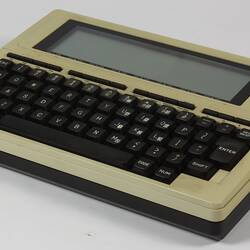Summary
Electric typewriter of the daisy wheel type, manufactured by Olympia AG of Wilhelmshaven in Germany.This particular typewriter was used as a printer attached to an Amstrad PPC640 portable compact computer, dating from about 1989.
The Amstrad has all its accessories and attachments. It includes PC2000 integral modem and Mirror II software for early use of Internet connectivity (never used). It has a Supertwist LCD screen, dual floppy disk drives (3 1/2" floppy), full keyboard and an internal battery pack. There are expansion ports in the rear to which a monitor and printer could be connected. A hard drive could be connected if wished.
Physical Description
Beige coloured standard electronic typewriter. Paper holder folds out from the top of the back of the typewriter and the carry handle folds out from underneath the keyboard. Five-row QWERTY keyboard with 52 character keys and 13 control keys. Detachable cover over printing mechanism. Power switch and connector are on the left of the typewriter in the bottom left hand corner. Included are several alternative daisy wheels. spare ribbons, and operating instructions.
Significance
If the items are acquired, the donor has agreed to write a short history of her experience with this computer; she will include the various reactions to what she did and how attitudes did or did not change.
Peter Thorne (9 Dec 2004) stated that this is an interesting item because Jennifer Jackson chose to personally purchase the computer to sort out work problems. Peter said that most computers, used by women, are chosen by men (eventually her employers bought a PC for her use).
In her offer, Jennifer wrote: "I haven't used it for some years now and it has been stored in a cupboard. I bought my Amstrad when I was tired of doing pages of lengthy calculations by hand at home and the office. (This eventually prompted my employers to give me an office PC.) The Amstrad has all its accessories and attachments. It is quite weighty! Can't quite remember the year I bought it, but it would have been about 1989 - the manual is dated 1988. Amstrad were the 'in thing' at the time too."
Peter Thorne felt that it was important that the Museum included Amstrad machines to make its collection more representative. Amstrad played in key role in developing the PC market. In 1984, Amstrad launched the first mass market Home Computer package (CPC range), designed by Amstrad engineers in the UK. This product captured the market from the existing players Commodore and Sinclair. In 1985 Amstrad launched the first mass market dedicated Word processor (PCW 8256). This product opened up a previously untapped market. In 1986 Amstrad launched the first mass market IBM compatible PC (PC 1512). At £399 this unit was less than a quarter of the price of established market leaders. Within 6 months of its launch Amstrad captured 25% of the European Personal Computer market. Nowadays (2005) Amstrad is involved in communications and internet equipment.
The inclusion of these items in the collection will make the collection more representative of the development and use of computers. Jennifer's story of the use of the computers adds to our understanding of the social impact of computers.
More Information
-
Collecting Areas
-
Acquisition Information
Donation from Ms Jennifer Jackson, 18 Feb 2005
-
Manufacturer
-
Inscriptions
Above the keyboard: left 'CARRERA' right 'OLYMPIA' Silver coloured label on bottom of the typewriter in black text: 'OLYMPIA AG / WILHELMSHAVE/MADE IN GERMANY / 110-120/220-240 V -50HZ 30 W / INTERFERENCE ELIMINATED' There are logos on this label too and down the left side of this label reads: '25.200-4540.1 [03]'
-
Classification
-
Category
-
Discipline
-
Type of item
-
Overall Dimensions
440 mm (Width), 340 mm (Depth), 110 mm (Height)
-
Keywords








